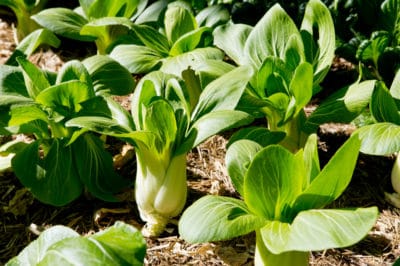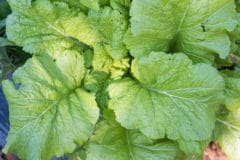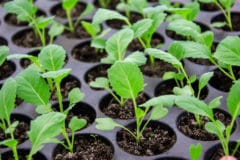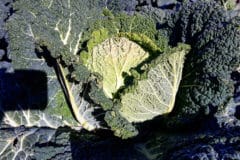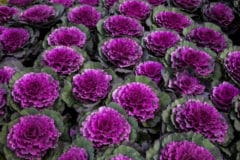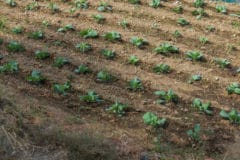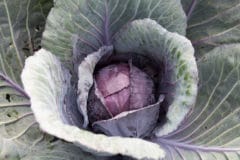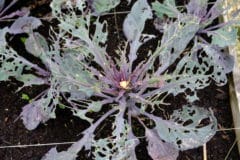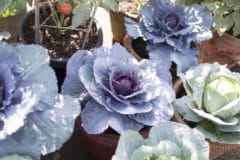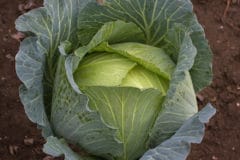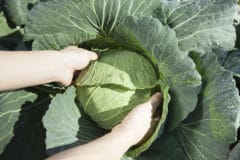When to Plant Bok Choy and Choy Sum
Both Bok Choy and Choy Sum are cold weather crops that bolt, go to seed, easily when exposed to warm weather after being exposed to cold weather. A period of warm weather followed by cold weather tells these plants that winter has passed, that spring has come, and that they are into their second growing season. That is why cabbages usually are grown as annuals.
For spring planting, you can start both Bok Choy and Choy Sum indoors from seeds four to six weeks before the last frost date in your area. Keep the seeds in a sunny location or place them under a grow light or a white fluorescent light. Choose a location where the temperature remains between 55°F and 70°F (13°C to 21°C).
Wait to transplant your cabbages until the last frost date has passed and both nighttime and soil temperatures remain above 50°F (10°C). If you plan on sowing your seeds directly into the soil, you still should wait until temperatures remain steadily above 50°F (10°C).
After your initial spring planting, you can sow new seed every two weeks to create a continuous harvest for your stir-fries and salads. You can continue planting until summer temperatures begin to reach the high side. Hot, dry conditions will also cause Bok Choy and Choy Sum to bolt.
In mid- to late summer, you can resume sowing your seed in preparation for fall harvests.
Where to Plant Bok Choy and Choy Sum
These two cabbages can grow in any type of soil, from sandy or loamy to clay, as long as it is rich with compost or organic matter from other sources. Loamy, sandy soil drains more readily, though, and the spot you choose for these cabbages should retain moisture to a depth of 6 inches but drain well on the surface. Avoid an area where surface water collects or where the surface soil remains muddy for extended periods.
The soil should have a pH balance of 6.5 to 7.0. If the soil lacks sufficient nutrients, work a 2- to 3-inch layer of compost into the soil or add a 20-20-20 blend of organic fertilizer following the directions on the package. If you will be using an organic fertilizer, apply it at least two weeks before planting.
When you are planting these cabbages in containers, use a loamy or sandy potting soil that is blended for vegetables or vegetables and herbs. Again, the pH balance should be between 6.5 and 7.0. Containers should be at least 8 inches in diameter, have ample holes for drainage, and the holes should be lined with pebbles.
Both Bok Choy and Choy Sum prefer full to partial sun. Full sun is best for early spring planting. When temperatures begin to rise, partial shade keeps these cabbages cooler. Both require three to five hours of sunlight per day.
Rotating crops — especially cabbage and its close relatives like kale, broccoli, cauliflower, Brussels sprouts, and collard — is an important step for reducing annual infestations of pests and diseases. If you planted any of these crops in a particular space during the previous growing season, plant an unrelated crop there for the next growing season and plant these related veggies in areas where you grew unrelated crops.
How to Plant Bok Choy and Choy Sum
If you are starting your seeds indoors for early spring planting, reduce the chances that they will bolt after transplanting by sowing them in biodegradable paper or peat moss pots or cut-off toilet paper tubes that will protect your cabbages from cutworms and cabbage root maggots after they are transplanted.
Whether you are sowing your seeds indoors or outdoors, space them 1 inch apart and cover them with 1/2 inch of soil. Depending on the size of the mature cabbage, thin your seedlings to 6 to 12 inches apart when they are 2 inches tall. Outdoors, rows should be 18 to 30 inches apart.
Transplant cabbages when they are 4 to 6 inches tall and have three to four true leaves. Transplanted cabbages should also be spaced 6 to 12 inches apart in rows that are 18 to 30 inches apart.
Cabbages planted in containers also should be sown 1 inch apart and covered with 1/2 inch soil. Thin the plants to 6 to 12 inches apart when they are 2 inches tall.
Caring for Bok Choy and Choy Sum
- Placing mulch around your cabbages helps the soil to retain water, which reduces the chances of bolting. Check the soil daily. You should let the top 1 inch dry out between each watering, but the lower layer of soil down to 6 inches should remain moist.
- To prevent bolting, water as often as necessary to maintain the above conditions, whether that means watering every two to three days or watering daily.
- Use a soaker hose in your garden to keep water off of the leaves of your cabbages. This will help prevent diseases such as black rot.
- Apply an organic fertilizer that is high in nitrogen around each cabbage about halfway through the growing season.
- To prevent pests like the imported white cabbage moth, the diamondback moth, or the cabbage fly from laying caterpillar-producing eggs on or around your cabbages, cover them with row covers as soon as you sow your seeds or transplant your seedlings. Row covers also protect your cabbages from pests like aphids, flea beetles, and harlequin bugs.
- Anchor your row covers by burying the edges in the soil.
- Inspect your cabbages regularly for eggs, caterpillars, aphids, flea beetles, and harlequin bugs. Aphids can be knocked off of your cabbages with a flick of water from your garden hose. The eggs, caterpillars, and other insects can be removed by hand. Have a bucket containing a mixture of water and dishwashing liquid on hand, and drop the caterpillars in it to drown.
- Organic sprays made from garlic, tomato leaves, or dishwashing liquid also discourage pests, as does the naturally occurring organic pesticide Bacillus thuringiensis.
- Sprinkle diatomaceous earth around the base of your cabbages to pierce any soft-bodied pests such as caterpillars and aphids. This dehydrates and kills them.
- Planting flower beds near your vegetables attracts lady beetles, lacewings, hoverflies, yellow jackets, and Trichogramma wasps. All of these prey on garden pests like aphids and cutworms.
- Planting trees and shrubs provides daytime roosting places for fireflies, which also prey on nocturnal cutworms.
- Companion plants, such as nasturtiums, mustard, bittercress, dill, mint, and others, can repel pests away from your cabbages, lure pests to another area of your garden, add beneficial nutrients to the soil for your cabbage, or even enhance the flavor of your cabbage.
Harvesting Bok Choy and Choy Sum
Harvest both Bok Choy and Choy Sum by using a sharp knife and cutting them from the stalk at the base of the cluster of leaves. If you leave about 1 inch of the stalk, it will produce a new plant, giving you a second harvest. After the second harvest, however, you should pull the plant out with the roots to prevent disease.
You can harvest these cabbages after they bolt. Wait until the flowers appear to harvest them. You can use the flowers in salads.
